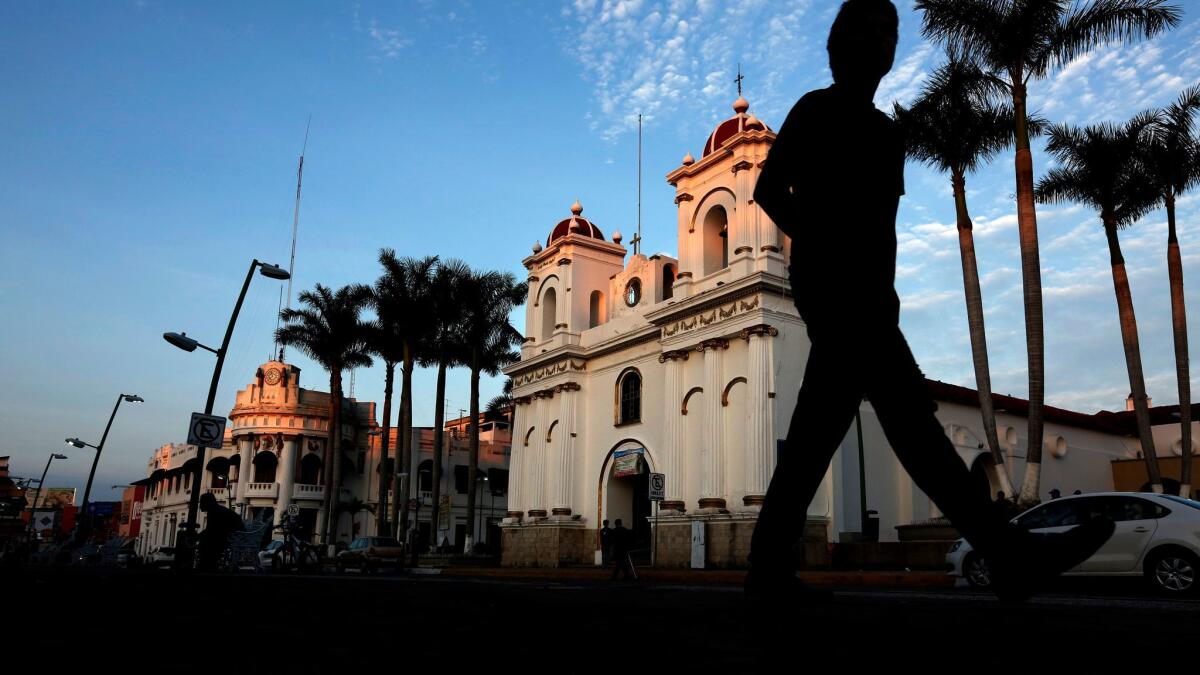Bitter, disbelieving: Cuban migrants en route to U.S. hope for some kind of eleventh-hour reprieve

- Share via
Reporting from Tapachula, Mexico — This sweltering town just north of Mexico’s southern border with Guatemala is a three-day bus jaunt from the U.S.-Mexico frontier, a fact that has long drawn migrants from across the globe en route to the United States.
Images of the Stars and Stripes and the Statue of Liberty adorn travel agencies offering cheap ground transport to Tijuana, Reynosa and other Mexican border cities. Flophouse hotels and various shelters provide sanctuary to the polyglot wanderers. The USA seems just a step away.
“The American Dream is something that everyone believes in, from Cubans to Mexicans,” said Daimy Suarez, previously a physical trainer in Cuba.
Suarez was among more than 200 Cuban migrants who staged an impromptu demonstration here Friday to protest what for them is a staggering blow: President Obama’s decision announced the day before to end decades of preferential immigration treatment for Cuban nationals.
For years, Cubans who traveled to Florida in rickety boats would be sent back to the communist-run island if they were intercepted at sea. But if they reached U.S. soil, they would be granted temporary residency and an easy path to citizenship.
By contrast, masses of Mexicans, Central Americans and others without visas or valid asylum claims could only stay if they sneaked across the border, often without hope of ever attaining legal status. Many fled deep poverty and social turmoil, but had no chance to receive the privileged treatment accorded to Cubans.
It was a kind of affirmative action for Cuban migrants, a testament to the power of geopolitics and Cuban American politicians, especially in South Florida. Cubans’ entitled status was an outgrowth of the Cold War, part of Washington’s multigenerational enmity for the Castro regime in Havana.
With the stroke of a pen, Obama did away with a special status long derided as one of the most inequitable aspects of U.S. immigration policy. Cubans can now be deported like any other migrants attempting to enter the U.S. illegally.
“While we want all immigrants to have a chance to prove that they lawfully qualify to remain in the country, many immigrant groups have found that Cubans had an unfair advantage,” said Jessica Farb, directing attorney for the Immigration Center for Women and Children, which has offices throughout California. “Stripping this policy will now put Cubans on the same playing field as other hopeful immigrants.”
Even some Cuban Americans weren’t sorry to see the end of the policy that became known as “wet foot, dry foot.”
“It was an outrageous program,” said Al Fox, a Tampa-based Cuban American who has long advocated for the normalization of relations between the two countries. “It was being abused on a massive scale, and the American public have simply been unaware of it.”
He contends that most of those who were allowed into the U.S. and given aid weren’t people who had been beaten, jailed and repressed in Cuba, but people who left in search of economic opportunity.
“Many would open joint bank accounts here in the U.S. with a relative and go back to Cuba and just collect their monthly checks from the American government,” he said. “It was essentially stealing.”
Before this week’s decision, rumors had been circulating for months that the Obama administration would end the preferential regimen as part of the broader effort to normalize relations with the island.
That rumor prompted a new rush of Cubans off the island, this time not via sea, but through a circuitous land route from South America to Central America, then to Mexico and the U.S.-Mexico border. That was because most countries, including Mexico, refused to grant visas to the Cubans. So they opted to fly from Cuba to visa-friendly South American nations like Brazil and Guyana, and then set out on their tortuous land journeys.
Close to 40,000 Cubans arrived at the Southwest U.S. border in the 11 months ending last August, according to U.S. authorities. That represents an almost fourfold increase compared with 2012.
As it turned out, they were the lucky ones: They are in the United States, on a glide path to legal residency and citizenship, to being reunited with their relatives and friends.
But the Cubans in Tapachula — along with hundreds, if not thousands of other Cubans still stranded in South and Central America and elsewhere in Mexico, crammed into camps, cheap hostels and cut-rate flats — have run out of luck. They are bitter, disbelieving, hopeful of some kind of eleventh-hour reprieve, perhaps from President-elect Donald Trump’s administration.
“For us, after so much travel through so many countries, it’s very difficult because we are on the verge of attaining what we all wished for,” said Osmani Rodriguez, who was among the Cubans protesting here Friday in front of the offices of Mexico’s National Migration Institute.
“Now we don’t know where we stand,” added Rodriguez, formerly a driver in Cuba, who said he had been on the road for six months.
One after another, they recounted tales of their perilous journeys — of navigating the Darien Gap, a notoriously dense stretch of jungle on the Panamanian border, on foot. Of facing organized bands of ripoff artists in places as far flung as Brazil, Peru and Nicaragua. Of crossing borders illicitly in the dark of night. Of being broke and hungry on foreign soil, imploring relatives in the United States via cellphone to wire more dollars right away.
Most said they had used up all their savings and even sold their homes; many owe thousands of dollars to relatives and friends who bankrolled their odysseys.
Now they wonder: Was it all for naught?
“We have nothing left in Cuba,” said Luis Gonzalez Pulido, another Cuban who took to the streets here. “We don’t have homes anymore. We have problems with authorities there. All we wanted was to reach the United States, nothing more. Why can’t they just let us through?”
That now appears highly unlikely. Apart from going home — a choice most seem to reject — U.S.-bound Cubans lacking visas would seem to have one main option: continuing their journeys north to the U.S.-Mexico border and getting in line with the multitudes, hopeful of navigating that ever more-imposing barrier to the long-cherished American Dream.
Special correspondent De Dios Garcia reported from Tapachula and Times staff writer McDonnell from Mexico City. Staff writers Kurtis Lee and Alexandra Zavis contributed reporting from Los Angeles, and special correspondent Les Neuhaus contributed from Tampa, Fla.
ALSO
Op-Ed: Canada’s sanctuary for migrants is built on a strict immigration policy
More to Read
Sign up for Essential California
The most important California stories and recommendations in your inbox every morning.
You may occasionally receive promotional content from the Los Angeles Times.










